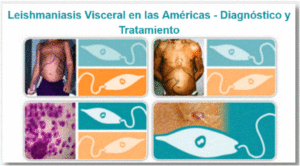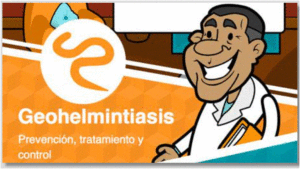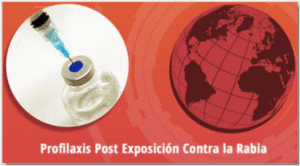Since 2012, BIREME and PAHO’s Department of Communicable Diseases and Health Analysis (CHA/PAHO/WHO) have been developing projects to build courses focusing on the prevention, control and eradication of communicable diseases and zoonoses. These courses are self-teaching with free access and published on the Moodle platform of the Virtual Campus for  Public Health (VCPH). There are already 11 projects for courses on Cutaneous Leishmaniasis, Visceral Leishmaniasis, Geohelminthiasis, Rabies, Trachoma, and Schistosomiasis, focusing on the diagnosis, prevention, control and treatment of these diseases.
Public Health (VCPH). There are already 11 projects for courses on Cutaneous Leishmaniasis, Visceral Leishmaniasis, Geohelminthiasis, Rabies, Trachoma, and Schistosomiasis, focusing on the diagnosis, prevention, control and treatment of these diseases.
In addition to the courses, this partnership has yielded a considerable collection of Open Educational Resources (OER), such as video classes, audios, animations, and a selection of references of documents of the Virtual Health Library (VHL) specific for each course. OERs are stored, preserved and published on the digital repositories of the OER Network.
In these projects, BIREME contributes with the pedagogical orientation of the educational design of courses, selects the scientific reference documents of the BVS, creates a theme-specific library aligned to the course, until its implementation. CHA/PAHO/WHO’s specialists indicate, update and adjust the content on neglected diseases for the online and self-teaching modalities.
These actions contribute to support the surveillance, control or elimination of neglected diseases in the Americas. Moreover, it is an education and training strategy for physicians and other healthcare professionals, to improve technical capacity and the care delivered to the population affected.
Dr Marcos Espinal, Director of the Department of Communicable Diseases and Health Analysis in PAHO/WHO’s headquarters in Washington, D.C., said that “ These self-teaching courses have contributed to strengthen the technical cooperation between PAHO and member countries, and represents in a concrete manner part of the commitments assumed in the Resolutions approved by the Steering Committee. In addition to that, we are using strategies, low cost complementary technological tools to support and improve the teaching-learning process of our professionals. Results already show the reach that these courses may offer, providing extensive knowledge dissemination, opening opportunities for healthcare professionals, of the many countries in the Latin-American and Caribbean region have free access to knowledge and à self-learning para improve a efficiency and quality of care and surveillance services in our region”.
These self-teaching courses have contributed to strengthen the technical cooperation between PAHO and member countries, and represents in a concrete manner part of the commitments assumed in the Resolutions approved by the Steering Committee. In addition to that, we are using strategies, low cost complementary technological tools to support and improve the teaching-learning process of our professionals. Results already show the reach that these courses may offer, providing extensive knowledge dissemination, opening opportunities for healthcare professionals, of the many countries in the Latin-American and Caribbean region have free access to knowledge and à self-learning para improve a efficiency and quality of care and surveillance services in our region”.
According to Dr. Martha Saboyá, Specialist on Neglected Infectious Diseases, Tropical and Vector Borne Diseases (VT), Communicable Diseases and Health Analysis (CHA), “The collaborative work between BIREME and the Regional Program of Neglected Infectious Diseases is an example of how PAHO’s integrated work produces tools that strengthen the capacity of countries. Facilitating easy access, expanding information on EID and the resources to strengthen information on the management of Public Health programs in the Americas are good practices that should be kept and augmented”.
Finally, Dr Ana Nilce Silveira Maia-Elkhoury, Regional Advisor on Leishmaniasis for the Pan American Center for Foot and Mouth Disease (PANAFTOSA), says “Developing the self-learning courses for cutaneous, mucosal and visceral leishmaniasis in the Americas in partnership with BIREME, was to me a successful and fulfilling professional and personal exp erience.
erience.
In 2013, PAHO/WHO through its Regional Leishmaniasis Program and BIREME launched during the World Leishmaniasis Congress–WorldLeish5, the first issue in Spanish of the course on cutaneous and mucosal leishmaniasis. Since then, given the demand, the course has been also published in Portuguese.
The number of accesses and the reach of the course for healthcare professionals in the Region has been surprising. As an example, we highlight that for the course on cutaneous leishmaniasis, we have enrollments of more than six thousand participants from 32 different countries, 22 in the Americas, 5 in Europe, 3 in Africa, and 2 in Asia. Last year, according to VCPH information, the team based in Panama’s PAHO, 82% of participants had access to the course through mobile devices and 98% of participants said that the course was relevant for their professional development.
Being in the interior of a country where leishmaniasis is endemic, and hearing from a professional that the course they took was very important for their knowledge and improving their work, was an encouragement to persist and continue seeking tools and new strategies to strengthen technical cooperation between PAHO/WHO and the countries.”
See too
Online courses available and being developed
Reference Links
REGIONAL VCPH – https://courses.campusvirtualsp.org/
BRAZIL VCPH – http://brasil.campusvirtualsp.org/
OER NETWORK/PAHO – http://ops.oer.bvsalud.org/
BVS – http://www.bvsalud.org
1 Comment to "Online courses for the surveillance, control and elimination of neglected diseases"
Really it is best chance to me to upgrade my knowledge on leishemaniasis as I m focal person of this disease in my country.